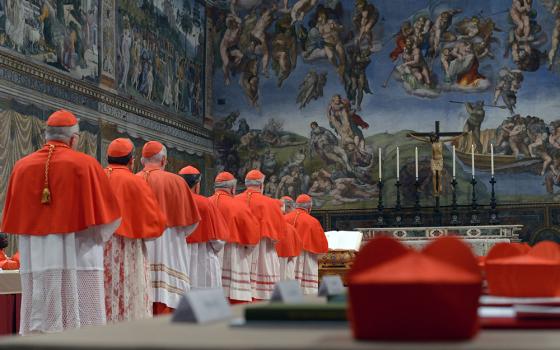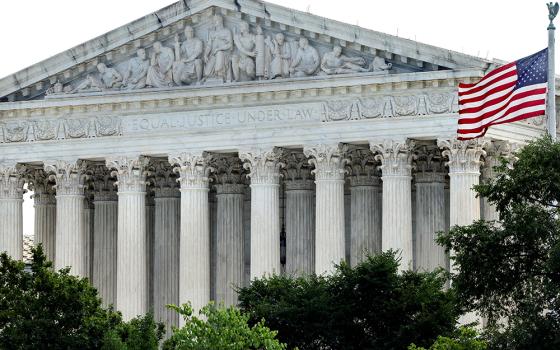
The Lateran Palace, pictured in 2007, was handed over by Constantine I to the Bishop of Rome, who converted the building into a temple during the fourth century. The Basilica of St. John, right, is the oldest church in Europe and the Cathedral of Rome. (Wikimedia Commons/Dnalor01)
The Vatican's system of interlocking directorates among the Curial cardinals who head the key Congregations (departments), means the pope has to contact only one or two cardinals to know what's happening everywhere.
—Peter Drucker, Concept of the Corporation
On Jan. 14, 1985, I wrote a four-page, 4,000-word article in Forbes magazine about the management of the Catholic Church, "the world's oldest and largest multinational enterprise." The article was headlined: "Managing the Lord's Work."
Five months later, on June 7, 1985, I wrote the front-page story and co-wrote the front-page editorial in National Catholic Reporter that exposed the nationwide Catholic priest pedophilia crisis. It described how Catholic bishops were engaged in a nationwide coverup of these moral and legal crimes. For the next two decades, these U.S. bishops continued to do little more than move the offending priests around.
Looking back three decades in Forbes, one can see that the Vatican was operating at a deficit, and yet "of greater concern" was dissent from the faithful and clergy as Catholics "cheer the pope" and "ignore his strictures on artificial birth control, divorce and homosexuality."
Those issues aside, there was much detail on how the church was actually managed.
Pope Pius XII (1939-58) had permitted the American Institute of Management (AIM) to investigate how the Vatican's management system worked. The investigation was updated in 1960, under Pope John XXIII.
The Forbes story detailed the tightness and closed nature of the management, as well as AIM's key Vatican advice to its own members: "Full authority for the top men once chosen."
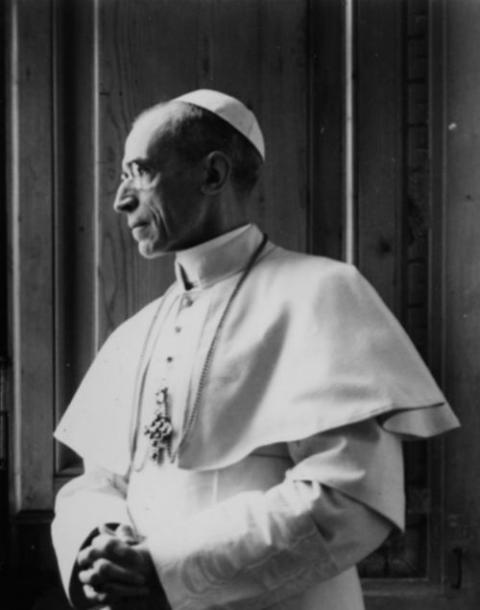
Pope Pius XII is pictured at the Vatican in a file photo dated March 15, 1949. (CNS file photo)
The Church-in-Rome's managerial closed shop, limited to selected male clerics, was at the root of the pedophilia crisis. Not for what it permitted, but for what the Church-in-Rome (pope, College of Cardinals, Curia and senior archbishops and bishops), i.e., the church bureaucracy, fostered: an exclusive Old Boys Club based on a rigid class system.
Some Catholic readers may be dismayed, indeed offended, by the detached and dispassionate manner in which the Catholic Church is discussed in what follows. True enough, "reducing the church's central 'mystery' to earthly parameters, is to risk the error of reductionism," as Benedictine Fr. Patrick Granfield (at that time president of the Catholic Theological Society of America), put it to Forbes, but "if the sense of 'mystery" as the religion's focal point is not lost, worldly analogies are useful."
Only by looking starkly at what the church bureaucracy has been doing can the reader see clearly the harm inflicted on what Catholics know as the Mystery, "the deposit of faith," for faced with the past 33 years of clerical sexual abuse and cover-up at the highest level of the institution, it is reasonable to ask: How in God's name had the community Jesus Christ founded come to this?
There are two answers: First, Emperor Constantine, and next, the living examples of famed English Catholic Lord Acton's dictum: "Power tends to corrupt, and absolute power corrupts absolutely." Those examples include many of the popes and their selected minions.
The ruling leadership's minions have sufficient power to corrupt if they are of a mind to give into it. That's why the corruption has not been limited to Rome. It has been potentially present wherever there is a priest, bishop or archbishop present, although, thank God, not all have been corrupted.
Making sense of two millennia of relatively untouchable and unassailable top-down power requires a short cut. Singling out those popes known as "Great" will suffice.
Christianity was a 3-year-old start-up when its founder was killed at age 33. Its product was salvation. There was no management structure beyond an anointed successor, Simon Peter, and he'd given no evidence he had the skills for the job. In fact, he'd been grossly disloyal to his boss. The rest of the chosen had fled at the first sign of danger.
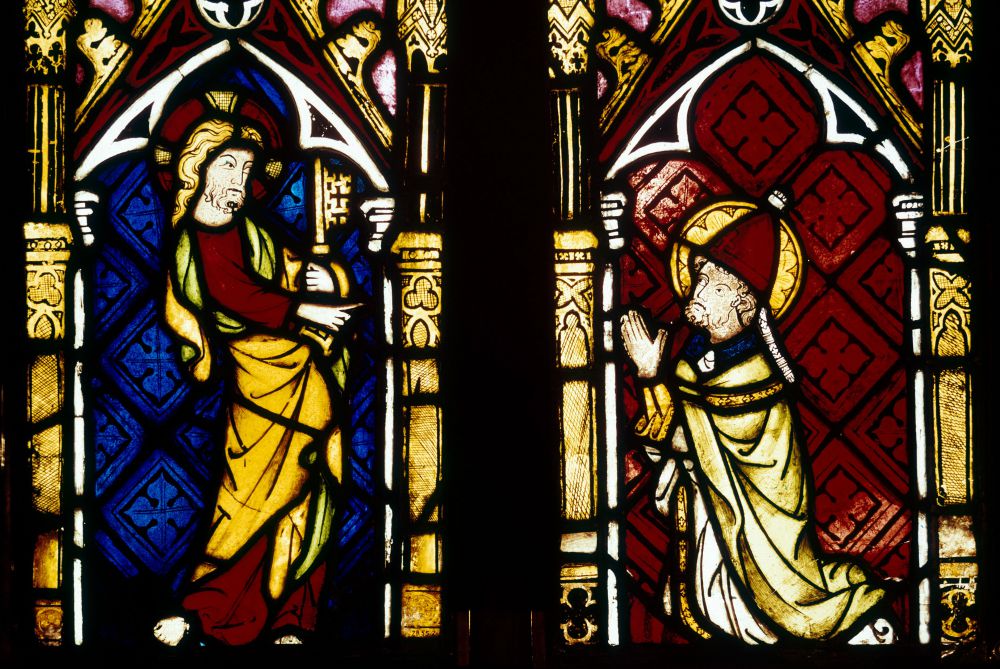
"Christ Presenting the Keys to Saint Peter," circa 1315-20, Cologne, Germany (Metropolitan Museum of Art)
At the time of Christ's death, there was no business plan. No agreement on who should do what, and an incipient mood suggesting that maybe the entire enterprise wasn't going anywhere. Still holding to a business analogy, the 12 men, who were inspirited after Jesus' murder and resurrection, were fired with the belief they had a message the world needed even if, at that moment, the world didn't know it wanted it.
The 12 deliberately set aside the world's goods and determined the only way forward was missionary— to preach and risk the consequences. A product without a name, without a universally understood logo, headquarters or any tangible proof that it worked.
The message was so convincingly delivered, so well-reasoned, so attractive in the light of the alternatives, that many people who heard it accepted it without proof. Initially, the ministry's adherents lacked a clear group identification until, in Greece, "in Corinth they were first called Christians."
The Founder, Jesus, a Nazarene carpenter, had used a logo, a fish. It had sufficed for a while (and it re-appeared as a bumper sticker in the late 1970s). In the first and second centuries, there was the Chi-Rho symbol, XP, the first two letters of Christ's name in Greek.

Statue of Pope Leo the Great, Germany (Wikimedia Commons/AnRo002)
Some contend the Chi-Rho was already the symbol of a Roman legion battalion and the Christians adapted it; others argue the reverse, that soldier-Christians embossed it on their shields. The Chi-Rho symbol traveled far, 2,000 years ago, and in the ancient Roman walled city of Chester, England, it was carved into rock by Roman soldiers.
The Christian organization was some 350 years old before it settled on the perfect symbol: the cross. Simple, symmetrical, graphic, lasting, adaptable to myriad design developments on the theme — and directly on-message.
Even by that time, there was still no generally agreed-on formal organization, though a rudimentary local management structure was coming into general practice: bishop, presbyter (priest), people. But before the fourth century was concluded, everything, organizationally speaking, would change dramatically.
For the first three centuries or so of Christianity, there was little evidence of physical permanence. The followers gathered in people's homes, or meetings were conducted in available premises. Synagogues and temples were considered very acceptable and in keeping with the tradition. Sometimes, as in Syria in 240 A.D., the oldest known example, a house had an inner wall knocked out to provide a greater meeting space, later dubbed a house-church.
The earliest datable purpose-built Christian meeting place in all of Greece and Macedonia, the Octagon in Philippi, is only from the beginnings of the fourth century, by which time the first churches were also being constructed in Rome.
And yet, by the fourth century, Christianity had already experienced almost everything it would continue to experience. It had been mocked, it was distrusted. It was outlawed, it was persecuted. It was driven underground, and it was feared. Yet it was so resilient, it survived. Kill one Christian and two seemed to pop up in his or her place. What rule of law there was worked against it.
The authorities began to recognize, however, that the message could not be contained because, wittingly or not, the organization had developed the perfect survival mechanism: every consumer, every customer for the product, was both recipient and emissary, each new convert became the next proselytizer. The customer base and the sales force were one.
Christianity had created the ideal message transmission system.
As Christianity became the hallmark of many Roman soldiers, there was the traveling promotional packet being circulated at someone else's expense. Christianity used the internet of the day — word-of-mouth. For much of the time in the early decades, and in many places, no one but other Christians quite knew for sure who was Christian and who was not.
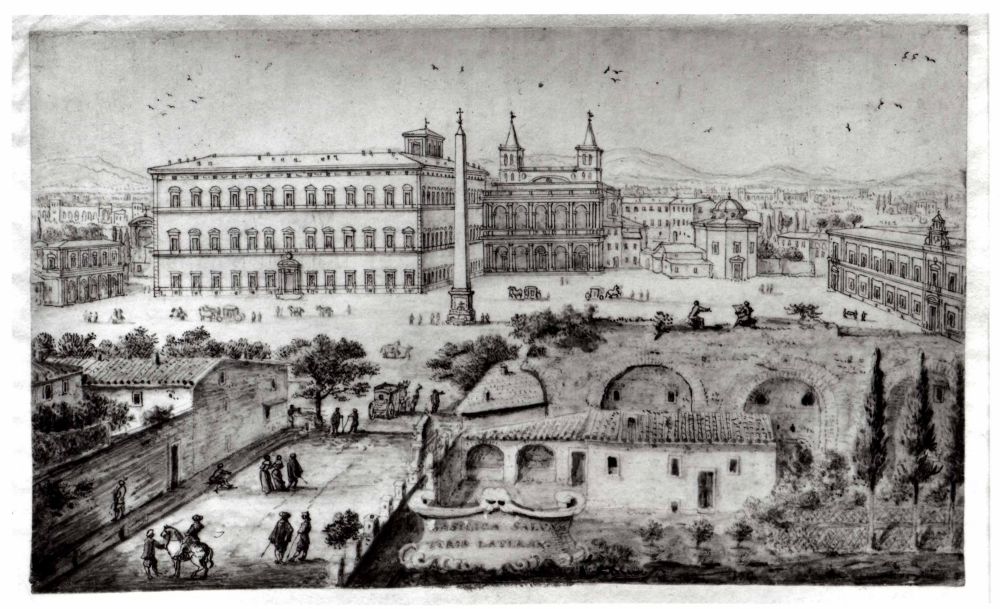
"View of Lateran, Rome," by Lievin Cruyl, 1672–73 (Metropolitan Museum of Art)
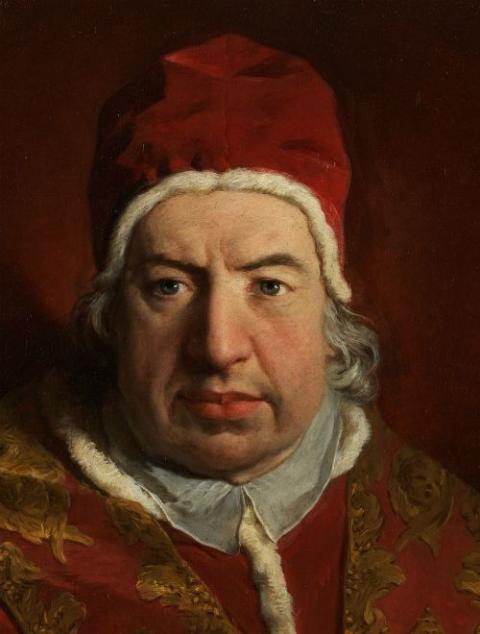
Detail of "Pope Benedict XIV" by Pierre Hubert Subleyras, 1746 (Metropolitan Museum of Art)
Emperor Constantine was Christianity's first celebrity product endorser. This new religion, Christianity, was a challenge and an opportunity. At one level he orchestrated a non-hostile takeover of the mystique and its utility to his structure, but Constantine had little interest in handling the Mystery packet itself (though he did later convert to Christianity and call a council). Constantine's takeover worked — at least to Constantine's satisfaction.
However, he wrecked the still fledgling organization by superimposing on it the imperial model and rational organization. He filled its bishops with delusions of grandeur that they handed down like a birthright to succeeding generations of hierarchs.
Constantine's next error was an enormous strategic disaster. The Emperor wanted a capital city all to himself. He constructed, according to his designs, Constantinople. The result was that the Christian church, like the empire itself, now had two centers: the Greek-speaking church in Constantinople (formerly Byzantium), and the Latin-speaking church in Rome.
The situation gave stark meaning to the adage "a house divided," for the church of the East in Constantinople considered itself in every way the equal to the church of the West in Rome.
Constantine's decision gave the Church of Rome a 1,000-year-long struggle for East-West primacy, which it lost. Indeed, managerially speaking, the papacy and Church of Rome, post-Constantine, were shaped in major measure by the continuing rivalry with its competitor, the Church in Constantinople (and equally shaped, sadly for the future, by Constantine's ideas of imperial grandeur).
The bishop of Rome wanted to dominate the market by dominating the Greek Church. In fact, in 1054, after 700 years, it yielded the Eastern market to Constantinople and contented itself with increasing the papacy's grip on the West.
Superiority complex
What Constantine had visited on the now flourishing Christian Church centered in Rome was an imperial superiority complex. This superiority complex, evident in most of its popes and bishops, has continued down to the present. In late antiquity, where Christians had been identified by their simple tunic in the face of Rome's lavish costumes, now the Christians with money attended Mass in expensive finery embroidered with scenes from the Scriptures.
Where house-churches and the temples of others had sufficed, Constantine set the tone for the popes by giving them his Lateran palace and creating for them huge imperial basilicas and ornate churches. The lavish style caught on, and soon "the church of the poor" had at least one church in Rome with an arch of solid silver over its altar.
The superiority complex took firm grip not merely on princely affectations by churchmen, it altered everything, from intergroup dealings and cooperation to its mode of communication with the outside world. It was not Queen Victoria who reportedly first used the royal we when she said, "We are not amused." It was Pope Leo the Great, 440-461. Royalty picked up the habit.
The American Institute of Management had a different take. In describing the church's management structure as "medieval and authoritarian," it warned that too much "line and staff responsibility is vested in the pope."
According to later tradition, Peter established himself in Rome, the center of the Empire, a move that in time gave the Bishop of Rome primacy over all the others.
So let's look at a few bishops of Rome later known as "Great." (with thanks to John Julian Norwich's Absolute Monarchs: A History of the Papacy.)
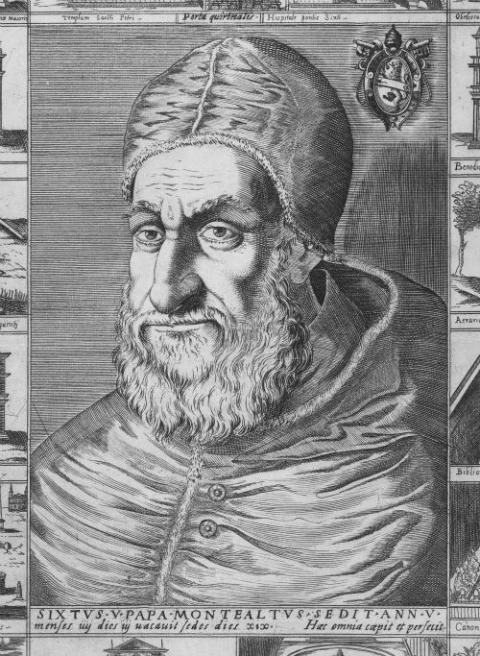
Detail of engraving, "Portrait of Sixtus V," published by Nicolaus van Aelst, circa 1589 (Metropolitan Museum of Art)
Leo the Great (440-461): Leo established the monarchy and used the royal "we" borrowed later by Queen Victoria. He ruled Italy and defeated barbarians. His letter, "Leo's Tome," written to the Council of Chalcedon in 451, led others to believe that "Peter has spoken through Leo." Leo claimed succession to Peter.
Gelasius I (492-496): Gelasius the African told rulers to back off and insisted that priests were more powerful than princes. He said that princes, too, wanted to enter heaven, but popes had the keys of the Kingdom.
Gregory I (590-604): As a senator, Gregory the Great was a lay administrator. He was the first monk to be elected pope, and introduced monks to the Lateran Palace, which was the church's headquarters before St. Peter's. He ruled the West because the emperors lived in Constantinople. Gregory called popes "the servant of the servants of God."
Gregory VII (1073-85): He was a papal finance minister who created imperial papacy. Gregory VII defied the Holy Roman Emperor, who submitted in the snows of Canossa in 1077. He was considered an austere reformer and was feared and revered.
Innocent III (1198-1216): Innocent became pope at age 37. He declared the Magna Charta invalid, and used the title "Vicar of Christ." He plundered Constantinople, made Orthodox reconciliation impossible and created the tragic Children's Crusade. He recognized the Franciscans and Dominicans, new breeds of religious who were urban, modern and poor.

Tomb of Pope Innocent III, left transept of the Basilica of St. John Latera, Rome, pictured in 2006 (Wikimedia Commons/©Marie-Lan Nguyen/CC-BY 2.5)
John XXII (1316-34): John was French and ruled from Avignon. He fended off counterpopes. He was lacking in scruples — five close relatives became cardinals — and made the papacy the richest monarchy in Europe. Dante put him in hell.
Sixtus V (1585-90): His was a short but effective reign. Sixtus kept to Franciscan simplicity but was nobody's fool. He put down bandits and was friendly toward Jews of Rome. He established the Roman curia in its modern form and organized the Counter Reformation.
Benedict XIV (1740-58): Lord Macaulay, a 19th-century British historian, said he was the greatest of the popes. His contemporary, Voltaire, said he "enlightened the Christian world before he began to rule it." Benedict was popular and learned. He walked the streets of Rome and chatted with his subjects. He founded learned academies. In his native Bologna, he encouraged the first women professors anywhere. Until John XXIII, no pope was so universally loved.
Pius XI (1922-39): A former Vatican librarian, he founded Vatican Radio to address the world. Throughout his papacy, Pius revealed toughness and a resilience of character, and he centralized the church to a degree never before possible. Roman universities received new and impressive premises; most bishops had attended them. The 1929 Lateran Treaty with Benito Mussolini ended "papal states" and the quarrel with Italy and gave the Vatican a general allowance. His Concordat with Hitler in 1933 harmed Pius's reputation, but he awakened to the evils of Nazism and he condemned communism.
No one ever said all these popes were holy. But they were Great. Great organization men. It was the organization, the centralization of power, that mattered, more, perhaps, at times than the sanctity of the message. Nine Great monarchs — out of 266 to date. All of them with one thing in common: the power to suppress and punish the challengers.
The power was unassailable as long as those outside the culture but still beholden to it could be made to believe the culture (i.e. the Church-in-Rome) was the gateway to salvation and heaven.
What frayed that culture was the primacy — in Vatican II (1962-65) — given to the Eucharist and the Scriptures.
Ordinary Catholics began to see for themselves which way salvation lay.
[Arthur Jones is a former editor and publisher of NCR.]
Read Part 2: Money, sex and absolute power corrupting absolutely
Advertisement


